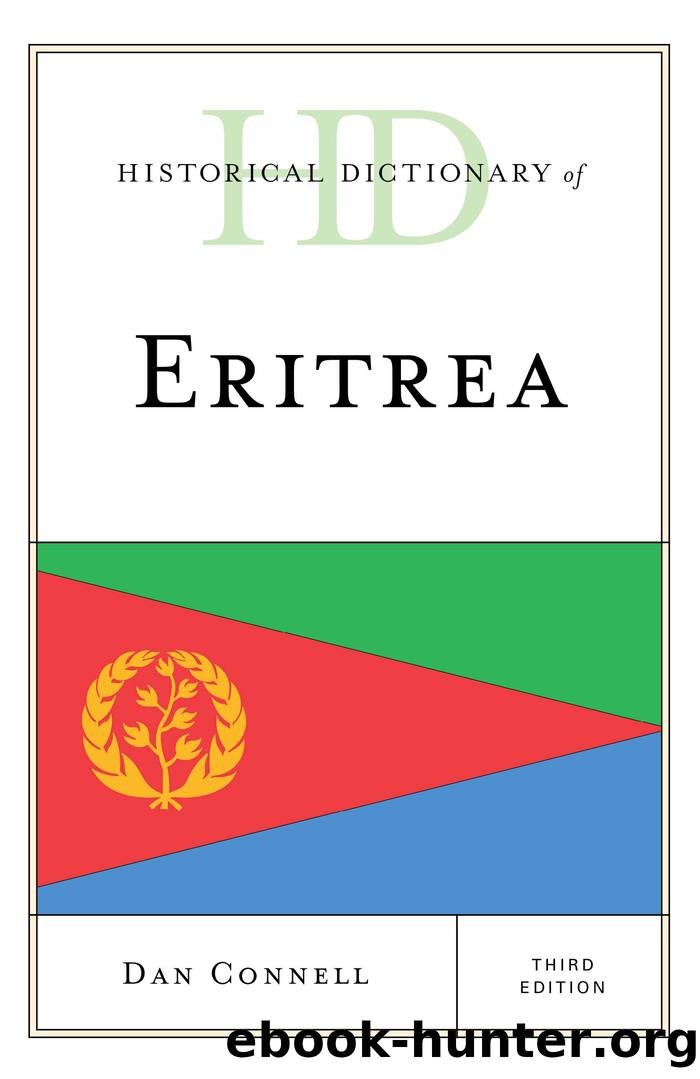Historical Dictionary of Eritrea by Dan Connell

Author:Dan Connell
Language: eng
Format: epub
Tags: undefined
Publisher: Rowman & Littlefield Publishers
Published: 2012-01-15T00:00:00+00:00
ITALIAN COLONIALISM (1882â1941)
Italy created the modern territorial entity of Eritrea through a period of colonial rule spanning 60 years. This rule may be divided into three phases: territorial expansion from 1882 to 1896; consolidation from 1897 to 1931, in which Italian rule was modeled on the âclassicalâ European colonial empires of the period; and Fascist expansion from 1932 to 1941, in which Eritrea became the main base for Italian conquest of Ethiopia.
Beginning with Italian attempts to acquire territory around Assab in 1869, Italyâs interest in Eritrea was focused on dominating the trade of Ethiopia, first by controlling its coastal entrepôts, then by expanding into the northern highlands. Italian activities were encouraged by Great Britain, which hoped Italy would prove a cooperative sub-imperial power capable of filling the political vacuum occasioned by Egyptâs withdrawal from the region. The first Italian colonial administration was established at Assab in 1882, and on 5 February 1885, the Italian navy seized Massawa. Over the next year, they occupied the central coast and extended treaties of protection to many lowland tribes including the Beni Amer, Bilen, and Habab. Italian occupation was welcomed by some Muslim lowlanders, who saw it as a form of protection from Tigrayan raids and the expansionist policies of Yohannes IV. Many Tigrinya/Christian military leaders also saw the Italians as allies against Tigrayan rule, including Aberra Kasa, Bahta Hagos, Hadgu-Ambessa, Berembras Kafle-Yesus, and others, who joined the Italians as leaders of irregular soldiers in banda units that were armed and paid by Italy.
Yohannes IV refused to accept the Italian occupation and, in January 1887, attacked their fort at Saâati, destroying an Italian column at Dogali. This defeat ironically propelled further Italian expansion, fueled by domestic calls for revenge. War was declared, 20,000 troops were dispatched to Eritrea, and diplomatic initiatives were launched to secure an alliance with Menelik II of Shewa. In May 1988, General Antonio Baldissera took command, and in 1889, Italy signed the Treaty of Uccialli with Menelik, by then emperor of Ethiopia, which recognized Italian possession of most of eastern Eritrea. In August, Baldissera occupied Asmara, and Italian rule was quickly extended to the MerebâBelesaâMai Muna line in the highlands (see BORDERS, NATIONAL).
On 1 January 1890, the Italian government created the Colony of Eritrea and set about securing their regime against attacks from Tigrayans, Sudanese Mahdists, and internal rebellion. A dispute over the Treaty of Uccialli led to a falling-out with Menelik, which the Italians countered with an attempt to win Tigrayan support in 1891. For the next five years, the Italian government led by Francesco Crispi, pursued a policy of demographic colonization in the highlands, while fighting a series of wars against the Mahdists to secure the western lowlands (see AGORDAT (15°32'56" N, 37°53'13" E)). Crispi hoped to settle thousands of Italian peasants in agricultural colonies that would redirect Italian emigration to Italian-controlled territory. But colonial seizure of Kebessa lands, many of which had been depopulated by famine, combined with the arrest of highland banda leaders, produced Bahta Hagosâs
Download
This site does not store any files on its server. We only index and link to content provided by other sites. Please contact the content providers to delete copyright contents if any and email us, we'll remove relevant links or contents immediately.
Goodbye Paradise(3729)
Men at Arms by Terry Pratchett(2784)
Tobruk by Peter Fitzsimons(2447)
Arabs by Eugene Rogan(2263)
Borders by unknow(2232)
Pirate Alley by Terry McKnight(2187)
Belonging by Unknown(1813)
It's Our Turn to Eat by Michela Wrong(1688)
The Biafra Story by Frederick Forsyth(1617)
Botswana--Culture Smart! by Michael Main(1560)
The Source by James A. Michener(1541)
A Winter in Arabia by Freya Stark(1506)
Coffee: From Bean to Barista by Robert W. Thurston(1489)
The Falls by Unknown(1488)
Gandhi by Ramachandra Guha(1488)
Livingstone by Tim Jeal(1452)
The Shield and The Sword by Ernle Bradford(1369)
Africa: Altered States, Ordinary Miracles by Richard Dowden(1353)
Egyptian Mythology A Fascinating Guide to Understanding the Gods, Goddesses, Monsters, and Mortals (Greek Mythology - Norse Mythology - Egyptian Mythology) by Matt Clayton(1331)
